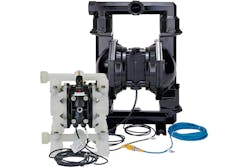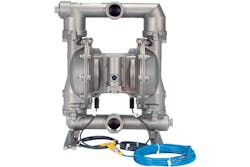Q: Which pump applications benefit more from electronic controls, and how so?
While electronic controls are beneficial in many fluid applications, they are particularly helpful during batching, dosing and metering applications.
During batching processes (such as filling a tank to a specific volume or weight), a simple control mechanism helps operators achieve the desired amount accurately by halting the pump at the exact moment it reaches the required level. Manual batching accuracy is typically affected since human error can be a factor.
Dosing processes pump chemicals or other ingredients into another fluid. Operators are informed about a process control function through the incorporation of an input signal from the control system (i.e., using a flowmeter). It’s important to note that not all air-operated double diaphragm (AODD) pumps can achieve accurate control without integrated electronic controls.
In metering applications, pumps are designed to move fluids at precise flow rates over a specified time period. These pumps rely on stroke rate to achieve a given flow delivery, but can also be enhanced or calibrated using external inputs from various sensors such as a flowmeter. However, the calibration of metering pumps can be fairly elaborate and require substantial operator training, which can cause issues given the wide range of operator skill sets.
Lastly, some pump manufacturers also offer tailor-made control solutions that can achieve the aforementioned functions. These solutions are practical to produce results without dealing with challenges associated with selecting new control system hardware and working through programming complexity.
Q: What level of automation should pump operators implement to achieve maximum efficiency for their operation?
This depends entirely on the operator’s desired outcome and long-term goals. The key to running efficiently is understanding the variables that require control and what is most important to the end user. In some applications, fluid processes are not routine, so manual control may be a better option. These processes don’t require the same precision as others, so manual control is a viable choice because it doesn’t result in lost downtime or significant wasted labor.
In other cases, like fluid processes such as batching, where fluids are processed within a given ratio or known volume, operations become repetitive. In these applications, automation can streamline operations by eliminating ratio and control issues thus increasing quality, and freeing up resources tied to the process operation.
Q: A lot of people are talking about the Industrial Internet of Things (IIoT) and its impact on the world of pump automation. As a process engineer, what should you be doing now to prepare yourself for the future?
The fluid industry is already seeing significant improvements in fluid processing and manufacturing as a result of IIoT. Among other benefits, data-driven technology has the potential to:
- Reduce maintenance resulting in lower costs and less downtime
- Deliver high fluid quality given enhanced process controls
- Allow for data to be analyzed easily via cloud computing
- Enable better process control through improved process analytics
In the future, process engineers can prepare by keeping agile and expecting things to change. This is especially important with process-industry-related equipment. While a pump operator may not need advanced pump features for the applications they are conducting presently, ensuring the pump can be upgraded in the future gives them the flexibility they need to stay current without having to replace equipment altogether. Many pump technologies such as AODD are adapting to these trends by becoming smarter and more process-related.
ARO diaphragm pump equipped with electronic interface capabilities
Q: How can you incorporate automation without encountering a great deal of system complexity or operational issues?
This is a critical question because automation should make fluid processes easier and more efficient. Some common issues should be considered to determine what type of automation, if any, makes sense.
Cavitation — Consider the various conditions you will need to process your fluids, as changes in viscosity or operating parameters can lead to cavitation. The effects of cavitation can lead to pitting, which can lead to adverse effects to tightly machined components found in certain types of pumps, such as gear pumps, leading to costly repairs.
Run-dry conditions — AODD pumps are well-suited for running dry, which simplifies their incorporation to automated systems as sensors are not required to limit the risks that other pump technologies encounter. For example, progressive cavity pumps need to incorporate separate sensors to limit damage to the stator, which occurs when they face run-dry applications.
Stalling under pressure — Temperature sensors aren’t required to monitor the heat buildup tied to the recirculation loops needed to turn off many motor-operated positive displacement pumps.
Changes in operating conditions — Fluid processes often have varying conditions, such as changes to the fluid’s viscosity, flow, pressure or temperature. Process engineers routinely make changes to make them "better," but they sometimes end up in situations where pumps do not work correctly. For example, AODD pumps can function reliably over a broad pressure and flow range while a centrifugal pump can drastically reduce reliability or efficiency with small changes in pressure or flow — as low as 10 percent. The other consequence is that changes to operating conditions can also drive a need for additional instrumentation to better control processes or yield the desired results.
AODD pumps are resilient to changing conditions, which allows for simplified system integration.
Electronic control benefits
The varying levels of electronic control offer operators a range of possibilities in processing. Controls and their
benefits include:
Input sensors for process monitoring
- End of stroke sensor
- Monitors pump volume and flow rate
- Provides maintenance intervals for decreasing downtime
- Offers closed-loop feedback regarding the pump’s performance
- Leak detection sensor
- Monitors failure of diaphragms
- Prevents spills and associated health risks
- Other sensors such as pH, load, flow, pressure, temperature
- Most of these sensors operate using a 4-20 mA signal and can offer insights regarding the operational conditions
- They allow for monitoring and control within specific
process parameters or tolerance
Device output for control processing
- Solenoid valve
- Starts and stops the pump to limit end-user labor and health risks tied to manual operation
- Limits wasted energy with automatic stop
Given the above fluid processing challenges, electronically interfacing pumps can yield efficient results including higher precision, safety and increased productivity.


